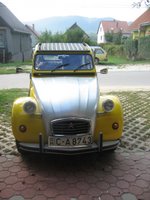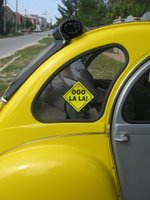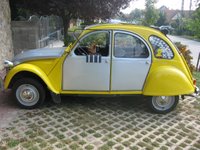


Ok. While I'm still digging this blogging stuff, I've decided that I should make a separate space for my newest adventure - my duck. For those of you who are pondering the possibility that I may have completely gone bananas (actually, that happened a long time ago), I am not referring to the feathered kind. It's yellow indeed, and even cuter than a real quacker, but it's actually a car. I will now proceed to borrow a bit of history from my very dear friend Holly, who incidentally bequeathed (i.e. sold) this treasure to me when she left Budapest at the end of the summer. In her journeys around the globe in this car, particularly in the US, Holly is approached almost daily with questions about her 'souped-up Volkswagon'. Please note: this is not a Volkswagon, this is a Citroen 2CV, ou en Francais, le deux cheveaux. Anyhow, a few words on the topic.....
The Citroen 2CV
The first prototype of the Citroen 2CV was built in 1937. World War II delayed production of the car until 1948. The 'Deux Cheveaux' (i.e. two horsepower) is also affectionately known to many as the 'duck. The appearance of the car was of little importance when it was designed. It simply had to meet requirements determined via a questionnaire used to determine what the French people really wanted in a vehicle. Thus, it had to be able to (1) carry four people comfortably with luggage in comfort and (2) carry a basket of eggs across a ploughed field without any breakage. A unique suspension system runs under the car and is interconnected front to back. When carrying a heavy load, the front of the car points upward - thus a headlamp control prevents the blinding of oncoming drivers. The gear lever and handbrake protrudes through the dashboard. The front-wheel drive gives the car a completely flat floor. Heat is provided theom the exhaust manifold, where it is directed via a tube into the car. Front windows are hinged in teh middle and clip up when open.
With only minor changes to the appearance of the bodywork, the same basic design was kept during the whole period of production. The first 2CVs were fitted with 375cc engines, were later increased to 425/435cc, and finally to 602cc, with a top speed of 70mph. The 2CV has a five gallon tank and gets 50 miles to the gallon, a big plus since we are now paying almost 6USD/gallon in Hungary. The engine was built to such high standards that no gaskets are needed. The unburstable two-cylinder, air-cooled alloy engine can be driven full out all day and has no radiator, no water pump, or other potentially troublesome components. The front brakes are placed inboard of the wheels. The car is so well-balanced it can drive on three wheels. The seats can be removed in seconds for an impromptu picnic, or so that a farmer can transport his pig to market (it also works well for a family of five with two small dogs - bit cozy, but fun).
Raids have been organized since the 70's, where hundreds of 2CVs travel around the world together, in the name of adventure and fun. Historical raids include Paris-Kabul,Afghanistan-Paris, Paris-Africa(Ivory Coast)-Paris, Paris-Persepolis-Paris. These very adventurous duck lovers drove more than 10,000 miles at a time through dry and dusty deserts, through streams, and over mountain ranges in a variety of climates across entire continents.
Initially intended as a simple, reliable, and economical car for all kinds of people in rural France, the 2CV became a huge production success story and now appeals to people all over the world. The last deux cheveaux rolled off the production line in July 1990. Over five million 2CVs were produced between 1948 and 1990, and approximately half a million remain on the road today.
There you have it, a few tidbits. Sounds like quite a machine, huh?? It is. I got it less than two weeks ago, so I'm still figuring it out, but I drive it every day. Biggest problem is that I keep flooding it when I start it, but I'm getting better. The boys are somewhere between elated and completely embarrassed when I pick them up at school, as they know that there's a 50% chance we will have to sit there for ten minutes while mom gets the car started :) It's definitely something to see. I think the French mothers at the school also look with a bit of quandry as to what this kooky amazon American woman is doing driving an old French car and bringing her children to the French school. Keep 'em guessing, right? After five years of taking my kids there every day, I must admit that I'm pretty oblivious to what they might be thinking, just as they are oblivious to me.
